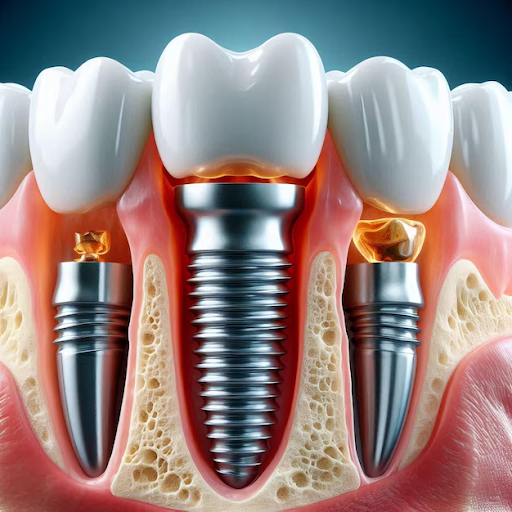
Dental implants have become a popular and effective solution for replacing missing teeth, offering both functionality and aesthetics. As the field of dental implantology advances, various types of implants and associated technologies have emerged.
Understanding the different types of dental implants can help both patients and dental professionals make informed decisions. Here’s a comprehensive guide to the most common types of dental implants available today.
Dental implants come in various designs to address different clinical needs and patient conditions. Here’s a detailed overview of some of the common types of dental implants, including Spiral Implants, Cylindrical Implants, Sinus Stopper Implants, One-Piece Bendable Implants, and O-Ball Mini Implants.
1. Spiral Implants: Maximizing Stability

Description:
- Design: Spiral Implants feature a helical or spiral thread pattern that helps enhance the stability and integration of the implant within the jawbone.
- Function: The spiral design allows for better initial engagement with the bone, providing high primary stability. This design can be beneficial in cases of compromised bone quality.
Advantages:
- Enhanced Stability: The spiral threads increase surface contact with the bone, improving implant stability.
- Immediate Loading: This can often support immediate or early loading due to increased primary stability.
Considerations:
- Bone Density: Areas with sufficient bone density; may require additional techniques in cases of significant bone loss.
Ideal For:
- Patients with sufficient bone density.
- Situations where immediate or early loading is planned.
2. Cylindrical Implants: A Classic Approach

Description:
- Design: Cylindrical Implants have a smooth, straight, or slightly tapered cylindrical shape. They are typically used in areas with good bone quality and sufficient bone volume.
- Function: The design focuses on providing a stable base for the restoration while maintaining simplicity in placement.
Advantages:
- Simplicity: Straightforward design that can be easier to place and align.
- Predictable Outcomes: Suitable for patients with good bone density and volume.
Considerations:
- Bone Adaptation: This may not be as effective in areas with less bone density or where bone quality is compromised.
Ideal For:
- Patients with adequate bone volume and density.
- Standard implant cases where a simpler design is sufficient.
3. Sinus Stopper Implants: Addressing Upper Jaw Challenges

Description:
- Design: Sinus Stopper Implants are designed specifically for use in the upper jaw where the sinus cavity can pose challenges for implant placement. They have a special feature that helps anchor the implant securely while avoiding the sinus cavity.
- Function: These implants are often used in conjunction with sinus lift procedures to create sufficient bone height in the posterior maxilla (upper jaw).
Advantages:
- Sinus Protection: Designed to avoid or accommodate the sinus cavity, reducing the risk of complications.
- Bone Preservation: Helps maintain bone structure and support in the upper jaw.
Considerations:
- Surgical Complexity: Placement may require additional procedures or modifications, such as sinus lifts.
Ideal For:
- Patients with inadequate bone height in the posterior maxilla.
- Cases requiring sinus lift procedures or similar interventions.
4. One-Piece Bendable Implants: Flexibility and Simplicity

Description:
- Design: One-Piece Bendable Implants feature a single-unit construction with a flexible or bendable design. This type of implant often combines the implant fixture and abutment into a single piece.
- Function: The flexibility allows for easier adaptation to anatomical variations and simplifies the implant procedure.
Advantages:
- Simplified Procedure: Eliminates the need for a separate abutment, reducing the number of components and potential complications.
- Adaptability: Can be adjusted or bent to fit specific anatomical needs.
Considerations:
- Durability: The one-piece design may have limitations in terms of long-term durability and adjustment options.
Ideal For:
- Cases where anatomical adaptation is needed.
- Patients seeking a more straightforward implant solution.
5. O-Ball Mini Implants: Compact and Effective

Description:
- Design: O-Ball Mini Implants are characterized by their small diameter and ball-shaped head. They are often used to stabilize dentures or for other specific applications requiring a less invasive approach.
- Function: The O-ball design allows for easy attachment of prosthetic devices, such as dentures, providing a stable and secure fit.
Advantages:
- Minimally Invasive: Smaller size and less invasive placement compared to traditional implants.
- Denture Stabilization: Effective for stabilizing removable dentures and improving patient comfort.
Considerations:
- Limited Applications: Best suited for denture stabilization or specific cases; may not be appropriate for all implant needs.
Ideal For:
- Patients needing denture stabilization or a less invasive implant solution.
- Situations where space is limited, and smaller implants are advantageous.
Each type of dental implant has unique features and applications that make it suitable for different clinical scenarios and patient conditions. Spiral implants provide enhanced stability, cylindrical implants offer simplicity, sinus stopper implants address sinus cavity concerns, one-piece bendable implants offer flexibility, and O-ball mini implants are suited for denture stabilization.
Whether addressing bone density issues or stabilizing dentures, selecting the right type of implant is crucial for achieving optimal outcomes and ensuring patient satisfaction. Understanding these options allows for more precise and effective treatment planning.
The variety of dental implants available today allows for tailored solutions that address different clinical needs and patient preferences. From the stability-enhancing spiral implants to the compact O-ball mini implants, each type offers unique benefits suited to specific situations.
By understanding these options, dental professionals can make informed decisions and provide optimal care for their patients.
At Dental Valley, we are dedicated to enhancing dental practices through a range of high-quality specifications. Our implants are designed with innovative technologies that streamline the placement process and improve overall efficiency. Backed by rigorous quality control and certification, Dental Valley implants provide dental professionals with reliable options that prioritize both function and aesthetics, ultimately enhancing patient outcomes in restorative dentistry.

